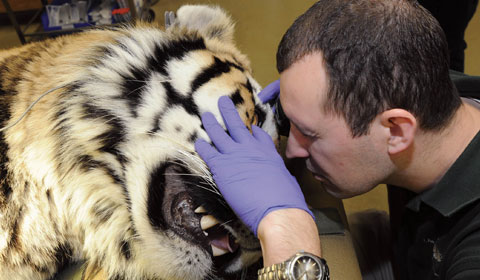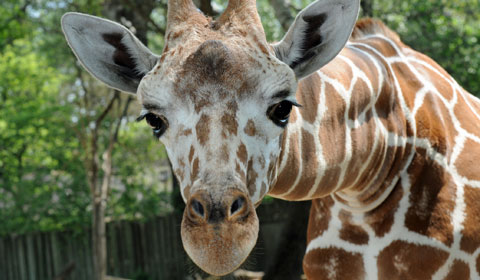News Release
Contact: Sondra Katzen, Public Relations, 708.688.8351, sondra.katzen@czs.org
August 11, 2016
FOR IMMEDIATE RELEASE
Note: Images of the fishing cat kittens may be downloaded here:
Fishing Cats-5339.jpg
Fishing Cats-5501.jpg
Fishing Cats-2958.jpg
Fishing Cats-3101.jpg
Fishing Cats-3120.jpg
Fishinhg Cats Born at Brookfield Zoo Make Their Public Debut
Brookfield, Ill.—Two fishing cats born at Brookfield Zoo on May 28 can now be seen in the Clouded Leopard Rain Forest habitat during the morning hours as they acclimate to their habitat. Once they get used to their new surroundings in a few weeks, they will be able to be seen throughout the day. Until now, they have been in their behind-the-scenes quarters bonding with their 5-year-old mother, Anna.
This is Anna and her mate Chet’s second litter. Anna was born at Parc zoologique de La Flèche in France, and 7-year-old Chet is on a breeding loan from Jackson Zoo in Mississippi. They were introduced to one another in 2013 and, in 2014, produced a female named Boon, who was sent to another zoo earlier this year. The pairing of the two adults and the transfer of their first offspring were based on recommendations from the Fishing Cat Species Survival Plan (SSP) of the Association of Zoos and Aquariums. An SSP is a cooperative population management and conservation program for select species in North American zoos and aquariums accredited by AZA. Each plan manages the breeding of a species to maintain a healthy and self-sustaining population that is both genetically diverse and demographically stable. Currently, 44 fishing cats live in 17 accredited North American zoos.
Once native throughout Asia, fishing cats are now found only in densely vegetated areas near marshes, mangrove wetlands, rivers, and streams in discontinuous areas of the continent. The species, which weighs between 15 and 25 pounds depending on its gender, is listed as endangered on the Red List of the International Union for Conservation of Nature and Natural Resources (IUCN). Like their name implies, fishing cats’ diet consists of fish, but they also eat crustaceans, mollusks, frogs, and small mammals. One of the biggest effects on fishing cats’ declining population is due to the Thai shrimp farming industry. More shrimp is imported to the United States from Thailand than from any other country (35 percent of the U.S. market). The shrimp farms take over the habitat that the cats need to survive. The public can help make a difference by purchasing only sustainable imported shrimp. To find out what the best choices are, go to seafoodwatch.org.
Another contributing factor to fishing cats’ decline is the increase in their habitat being settled, degraded, and converted to agricultural land. Over 45 percent of protected wetlands and 94 percent of globally significant wetlands in Southeast Asia are considered threatened.
Those interested in helping care for the fishing cats at Brookfield Zoo can contribute to the Chicago Zoological Society’s Share the Care program. The $35 basic package includes a 5-inch x 7-inch color photograph of a fishing cat, a personalized adoption certificate, a fact sheet about fishing cats, a Share the Care car decal, and an invitation to the 2017 Share the Care Evening. For further information, visit CZS.org/ShareTheCare.
# # #
About the Chicago Zoological Society
The mission of the Chicago Zoological Society is to inspire conservation leadership by connecting people with wildlife and nature. The Chicago Zoological Society is a private nonprofit organization that operates Brookfield Zoo on land owned by the Forest Preserves of Cook County. The Society is known throughout the world for its international role in animal population management and wildlife conservation. Its Center for the Science of Animal Care and Welfare is at the forefront of animal care that strives to discover and implement innovative approaches to zoo animal management. Brookfield Zoo is the first zoo in the world to be awarded the Humane Certified™ certification mark for the care and welfare of its animals, meeting American Humane Association’s rigorous certification standards. Open every day of the year, the zoo is located off First Avenue between the Stevenson (I-55) and Eisenhower (I-290) expressways and is also accessible via the Tri-State Tollway (I-294), Metra commuter line, CTA, and PACE bus service. For further information, visit CZS.org.
MEDIA CONTACT:
Sondra Katzen
Director of Public Relations
Office: 708-688-8351
Cell Phone: 708-903-2071
E-mail: Sondra.Katzen@CZS.org

Read about our innovative practices in animal welfare to ensure the ultimate care of our individual animals.

Create extraordinary connections with animals and nature!

Become our partner in caring for animals and in connecting people with wildlife and nature.